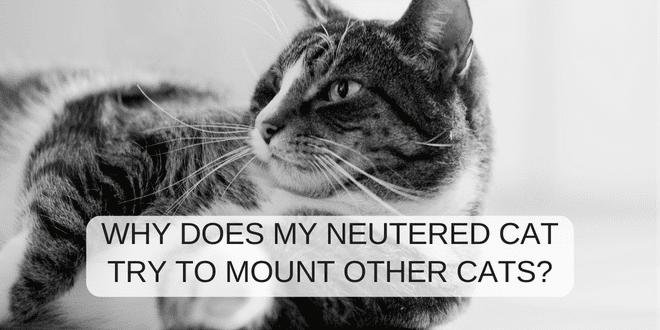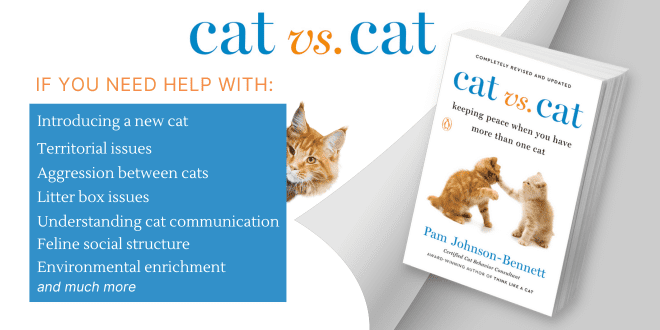
If this behavior happens out in a free-range environment with intact cats, or if we see it on a nature program, it’s something we understand as normal animal behavior. However, when it’s a neutered male cat attempting to mount a spayed female or even another neutered male in the household, it typically causes concern for cat parents.
Some Reasons for Mounting Behavior in Neutered Cats
Hormones
For most cats, this type of behavior stops after being neutered. The behavior may not stop immediately after castration surgery though. It may take weeks and, in some cases, months or even years. After neutering, there is a dramatic reduction in testosterone levels, but the hormone is still present just as a reduced level of progesterone will still exist in the system of the female cat. After neutering, the mounting may be less frequent than when the cat was intact, but, but it still may occur.
Social Interaction and Stress
Mounting behavior in neutered cats can also be due to the particular social dynamics within the group. Regardless of reproductive status, mounting may be an attempt at reinforcing social position on the hierarchy ladder. A resident cat may engage in mounting behavior toward a new cat introduced into the home. This is often related to anxiety.
Some cats display the behavior toward objects such as pillows or toys. This behavior may be an indication that the cat requires more interaction and constructive outlets for his energy. This behavior may be a stress-relieving activity. Some cats display the behavior for attention-getting purposes.
Learned Behavior
If the cat was neutered at an older age, and he had been engaging in mounting when intact, the behavior may continue out of habit.
Play Behavior
Sometimes, mounting behavior between neutered and spayed cats is displayed in a playful context. This interaction may be how a specific group of cats bond.
How to Reduce the Unwanted Behavior
It’s important to look at your cat’s specific situation, past experiences, social relationships with the other cat(s) in the home, and the context in which the behavior occurs. In some cases, no intervention on your part is required, but if the behavior causes distress, then a treatment plan should be implemented.
Neuter and spay. If cats aren’t neutered or spayed, obviously that step should top the list. Don’t make the mistake of thinking you just have to neuter the males without spaying females. It’s not just about eliminating the risk of pregnancy; it’s about reducing stress and creating an environment for healthy social behavior.
Consult your veterinarian. Make sure there isn’t an underlying medical reason for the behavior in the neutered male.
Never punish. Never punish a cat for exhibiting mounting behavior because it’ll only elevate stress levels. A cat who is attempting to mount due to social stress in the environment will only feel more anxiety if physically or verbally punished.
Increase vertical territory. Increase your cat’s sense of territorial security by expanding vertical territory. This can be done by way of cat trees, window perches, elevated walkways, and elevated beds. Vertical territory allows the cats to establish and maintain status more peacefully. Claiming a top elevated spot is an important factor in status.
Provide scratching posts. Scratching serves many purposes for a cat and one of them is to mark territory. This can also help in communicating status. It also serves as a displacement behavior to help relieve stress.
Resource availability. Provide multiple resources in multiple locations to prevent competition and jockeying for prime position. This means more than one feeding station, more litter boxes than cats, and plenty of napping, hiding, and personal space options.
Introduce new cats carefully. The addition of a new cat may trigger the behavior. To reduce the chances of this, do a gradual, positive new cat introduction.
Increase the fun factor. Increase physical and mental activity to give your cat beneficial outlets for his energy. Engage in interactive play sessions at least twice a day.
Other ways to occupy your cat’s time in a fun way is to set out puzzle feeders. This provides your cat with the opportunity to work for food rewards and help keep his mind occupied.
Work to improve relationships. In addition to the above suggestions, pay attention to the specific dynamics between cats so you can help them co-exist peacefully. This may just involve making environmental adjustments as mentioned above, or if the mounting behavior is of serious concern, you may have to separate them and do a reintroduction.
Pay Attention to Warning Signs
Pay attention to the body language signs indicating your cat may be about to engage in the behavior. This way you can provide more appropriate alternatives for his energy. Stash some interactive toys in each room so you can conveniently access one if you need to refocus your cat. Even tossing a fuzzy mouse, ping pong ball, or other little toy, may be enough to redirect him. Try to distract your cat before he engages in the behavior.
When petting your cat, watch for signs that he might be starting to get too stimulated. Your cat may have certain areas of the body that are too sensitive when petted, so stick to the spots that appear to cause relaxation. If he gets over-stimulated due to the length of time you pet him, be mindful of that so you can end well in advance of it.
Need More Help?
If the mounting behavior is of concern, and you need help, talk to your cat’s veterinarian about a referral to a qualified, professional behavior expert such as a veterinary behaviorist.
For more information on cat behavior and training, refer to the books by best-selling author, Pam Johnson-Bennett. For dealing with the unique challenges of living in a multicat household, check out the revised and updated edition of Pam’s best-selling book Cat vs. Cat. Pam’s books are available at Amazon and other online retailers, and in bookstores everywhere. For your convenience, we’ve included Amazon links here on our website.
This article is not intended as a medical diagnosis nor is it a replacement for your cat’s regular veterinary care. This article is for general information purposes only and is not dispensing medical advice.



